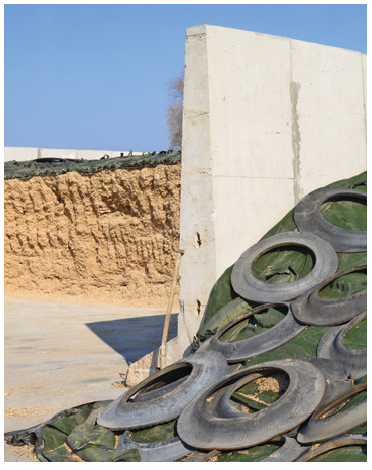Getting The Most Out Of Your Feedstuffs
Click here to view as a pdf: Getting The Most Out Of Your Feedstuffs
By Teresa Marker, B.S.
Dairy producers spend a lot of time, energy and money to grow, harvest and store quality feedstuffs that will be used to feed their livestock. Optimizing those feedstuffs by feeding a balanced ration will make the rumen more consistent and provide a stable environment for rumen microbes to grow which will help improve herd performance, productivity and profitability. Evaluating silage management, TMR mixing and bunk management on the farm are all useful areas that can be evaluated to help maximize the full potential of homegrown feedstuffs.
Harvesting and storing properly fermented feed is time consuming work. Proper silage management can help reduce shrink and preserve the quality of your livestock feed. Harvesting forages at the right time and moisture will reduce the possibility of poorly fermented feeds. Many producers use the Crystal Creek® inoculant , Inoc-u-Lock™ to help control fermentation and reduce the risk of dry matter loss. Inoc-u-Lock™ also preserves feed quality, stabilizes face quality and extends the bunk life of the forage. Once the feed is properly stored, the next focus should be on maintaining a good face. Always remove any spoiled or moldy silage prior to mixing feed for the animals. Keep silage piles small so that adequate silage is removed each day in order to stay ahead of heating. The use of a facer will help maintain a smooth face and minimize exposure of excess feed to the air. Make sure to observe the silage for any moisture differences, heating, mold or strong odors. If you do notice any differences, contact your nutritionist as soon as possible.
A ration from a nutritionist is only truly balanced if your feed is tested on a regular basis, mixed properly and delivered correctly. Regular audits of the TMR will improve accuracy of feed management on the farm. Crystal Creek® nutritionists are available to discuss how TMR audits are performed. The first step is to test feed on a regular basis and work with your nutritionist to properly balance the ration to optimize herd performance and profitability. Many farms have their own Koster Moisture Tester that they use on a regular basis to detect moisture changes in the feed. These producers then relay that information back to their nutritionist. Just because the paper ration says the ration is balanced, it does not mean the cows will receive a properly balanced ration. Correctly loading and mixing a TMR is key for delivering the right nutrition to your cows. An example of a proper loading order would be:
- Dry Baled Hay
- High Moisture Shell Corn
- Protein
- Mineral
- Haylage
- Corn Silage
- Liquids
If inconsistent feed is being delivered, either determined by visual observation or testing, the following should be areas of focus:
- Mixing order.
- Mixing volume (do not overfill the mixer).
- Process hay completely prior to adding other ingredients.
- Mix TMR for 5-6 minutes after last ingredient added.
- Regular maintenance of the TMR mixer. Evaluate mixer for worn blades, kicker plate condition, good clean out, load cells for accurate weighing and magnet.
- Mix feed on a level surface.
- Liquids need to be spread evenly over entire mix.
- Load feed in center of mixer.
- Do not mix too small of a load.
Once feed is mixed properly, delivery of that feed at the right time and management of the feed at the bunk is essential to maintaining good herd performance and improving feed efficiency. Prior to feeding fresh feed each day, the bunks should be cleaned out to remove old forage that may have some heating or mold. This is especially necessary during warm weather. Observe the bunks for weighback. Are the bunks empty? Is the weighback evenly distributed between pens? Are weighbacks hot or smelly? Does the weighback look like the original TMR mix? Aim to have around 3% weighback and never feed to an empty bunk. Once you have observed the weighbacks for each group, you can then make sure the right amount of fresh feed is available for the cows after milking. Push feed up often so cows do not have to stretch to reach the feed. Cows should never experience an empty bunk. Evaluate bunk space for the animals so each animal has space to eat. Milking cows require a minimum of 24” of bunk space. Headlocks are useful and help to reduce competition at the bunk as compared to a post and rail setup.
If you have questions on how to get the most out of your homegrown forages or how to properly evaluate feedstuff management on your farm, call a Crystal Creek® nutritionist and see what they can do to help with your farm’s profitability.

